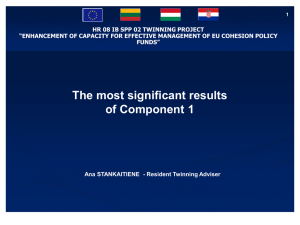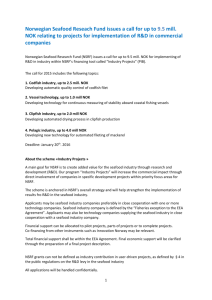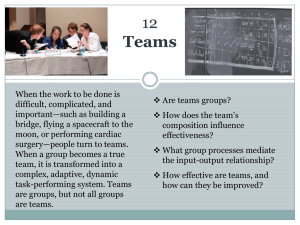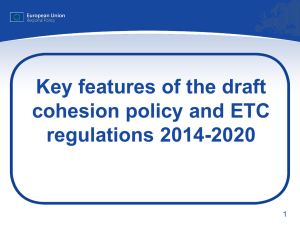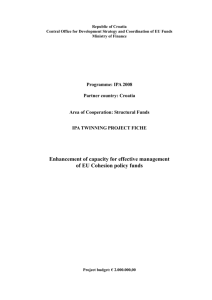The National Strategic Reference Framework (NSRF) 2007-2013
advertisement
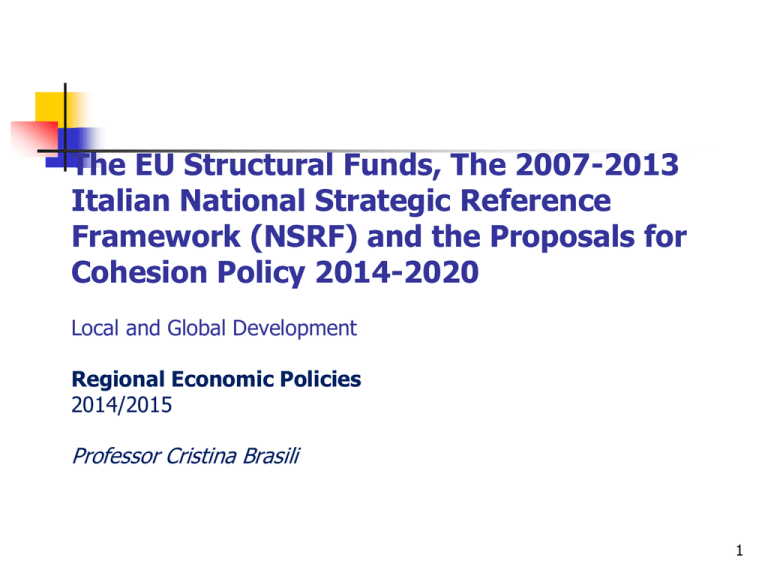
The EU Structural Funds, The 2007-2013 Italian National Strategic Reference Framework (NSRF) and the Proposals for Cohesion Policy 2014-2020 Local and Global Development Regional Economic Policies 2014/2015 Professor Cristina Brasili 1 Key Objectives The European Regional Development Fund (ERDF) , the European Social Fund (ESF) and the Cohesion Fund support the achievement of three objectives «Convergence», «Regional Competitiveness and Employment» and «European Territorial Cooperation». The rationale of the Convergence objective is to promote growth-enhancing conditions and factors leading to real convergence for the least-developed Member States and regions. In EU-27, this objective concerns – within 18 Member States – 84 regions with a total population of 154 million, and per capita GDP at less than 75 % of the Community average, and – on a “phasingout” basis – another 16 regions with a total of 16.4 million inhabitants and a GDP only slightly above the threshold, due to the statistical effect of the larger EU. 2 http://ec.europa.eu/regional_policy/atlas2007/index_en.htm •Convergence Regions •Phasing-out Regions •Phasing-in Regions •Competitiveness and Employment Regions 3 Outside the Convergence regions, the Regional Competitiveness and Employment objective aims at strengthening competitiveness and attractiveness, as well as employment, through a two-fold approach. First, development programmes will help regions to anticipate and promote economic change through innovation and the promotion of the knowledge society, entrepreneurship, the protection of the environment, and the improvement of their accessibility. Second, more and better jobs will be supported by adapting the workforce and by investing in human resources. In EU-27, a total of 168 regions will be eligible, representing 314 million inhabitants. Within these, 13 regions which are home to a total of 19 million inhabitants represent so-called “phasing-in” areas and are subject to special financial allocations due to their former status as “Objective 1” regions. 4 The European Territorial Co-operation objective will strengthen cross-border co-operation through joint local and regional initiatives, trans-national co-operation aiming at integrated territorial development, and interregional cooperation and exchange of experience. The population living in cross-border areas amounts to 181.7 million (37.5% of the total EU population), whereas all EU regions and citizens are covered by one of the existing 13 transnational co-operation areas. EUR 8.7 billion (2.5% of the total) available for this objective is split as follows: EUR 6.44 billion for cross-border, EUR 1.83 billion for transnational and EUR 445 million for inter-regional cooperation. This objective is based on the experience drawn from the former Community initiative – INTERREG. 5 The National Strategic Reference Framework (NSRF) 2007-2013 The NSRF (National Strategic Reference Framework) 2007–2013 constitutes the reference document for the programming of European Union Funds at national level for the 2007–2013 period. It was elaborated within the framework of the new strategic approach to the Cohesion Policy of the European Union, according to which NSRF “…ensures that the assistance from the Funds is consistent with the Community strategic guidelines on cohesion and identifies the link between Community priorities, on the one hand, and the national reform programme, on the other.” With this aim, Italy elaborated the National Strategic Reference Framework (NSRF) to distribute the resources allocated to our country by the EU cohesion policy, reaching out the South as well as North-Centre regions. The National Strategic Reference Framework (NSRF) contains Introduction The process of elaboration of the National Strategic Reference Framework (NSRF) 2007-2013 I CONTEXT: COMPETITIVENESS GAP AND DEVELOPMENT OPPORTUNITIES II REGIONAL POLICY: THEORETICAL FRAMEWORK AND PRACTICE III OBJECTIVES AND PRIORITIES IV OPERATIVES PROGRAMES BY GEOGRAPHIC MACRO-AREA ( Objs. CONVERGENCE, REGIONAL COMPETITIVENESS AND EMPLOYMENT, EUROPEAN TERRITORIAL COOPERATION) V FINANCIAL FRAMEWORK VI IMPLEMENTATION APPENDIX: INDICATORS AND TARGETS OF THE 2007-2013 REGIONAL POLICY Let’s have a look at the CONTEXT................... THE ITALIAN NATIONAL STRATEGIC REFERENCE FRAMEWORK (NSRF) for the regional development policy 2007-2013 Figure 6- Distribution of the GDP per capita in PPP (Purchasing Power Parity) in EU NUTS2 Regions (EU27) – 2003 Italian Regions Obj. CRO and phasing-in CRO Italian Regions Obj. CONV. and phasing-out CONV THE ITALIAN NATIONAL STRATEGIC REFERENCE FRAMEWORK (NSRF) for the regional development policy 2007-2013 Employment rate targets to be reached by 2010 according to the Lisbon Strategy and Employment rates value for Italy and EU in 2000 and 2005 Women Female Employment rate 15-64 anni (%) THE ITALIAN NATIONAL STRATEGIC REFERENCE FRAMEWORK (NSRF) for the regional development policy 2007-2013 THE REGIONAL POLICY: A SUPPLY-SIDE POLICY The NSRF departs from the assumption that economic growth is the result of the availability of abundant factors such as capital and labour, rather it stresses the fact that growth, and development more precisely, derives from the cohexistence of a number of conditions that define the context in which economic activities take place and economic agents interact (see the orginal version of the NSRF on page 50) THE ITALIAN NATIONAL STRATEGIC REFERENCE FRAMEWORK (NSRF) for the regional development policy 2007-2013 Lessons learnt from the 2000-2006 experience The evaluation activities carried out on the 2000-2006 regional policy aimed to ensure the effective performance of actions cofinanced by the Community Structural Funds: a system implemented at level of each programme and standardised as for methodologies procedures, techniques and contents. The evaluation analysis carefully examined the implementation and performance process of 2000-2006 Regional Policy and OPs programming and revealed both the achievements - at regional and national levels – as well as the factors had prevented reaching the prefixed targets. The analysis issued a positive evaluation of the general structure of the regional development policy, praising the fact that it is a supply-side policy that makes use of evaluation and monitoring systems, performance-based allocation criteria, multi-level governance and integrated territorial projects (see the orginal version of the NSRF on page 52). One of the most relevant innovation of the Community Support Framework (CSF) 2000-2006 is the identification and use of the BREAKTHROUGH VARIABLES The 1999 “Mezzogiorno” (Southern Italy) Development Plan (Reg. ce 1260/1999) states that It is necessary to identify the “break points” with previous experience and define a limited number of breakthrough variables on which to act Those breakthrough variables have been used as intermediate objectives to be reached by the programmatic actions 12 List of BREAKTHROUGH VARIABLES (I) 13 List of BREAKTHROUGH VARIABLES (II) 14 The 2007-2013 NSRF Approach is structured around 4 macro-objectives and 10 priorities a) Developing knowledge circuits Priority 1: Improvement and use of human resources Priority 2: Promotion, use and dissemination of research and innovation for the competitiveness b) Improving living standards, security and social inclusion Priority 3: Energy and environment: sustainable and efficient use of the resources for development Priority 4: Social Inclusion and services for the quality of life and territorial attractiveness c) Fostering clusters, services and competition Priority Priority Priority Priority 5: 6: 7: 8: Use of natural and cultural resources for the attraction and development Networking and connections for mobility Competitiveness of production systems and employment Competitiveness and attractiveness of cities and urban systems d) Internationalising and modernising the economy Priority 9: International opening and attraction of investments, consumption and resources Priority 10: Governance, institutional capacity and competitive and effective markets 15 The Ten Priorities of the NSRF 2007-2013 Priority 1: Improvement and development of human resources Aimed at promoting the dissemination of high levels of competence, equity of access and capacity for continuous learning for the population. It promotes the actions that can trigger the necessary recovery, especially in the South, of the knowledge, skills and competences of the youth and to integrate or update the competences of the adults. Priority 2. Promotion, use and dissemination of research and innovation for the competitiveness It focuses on the commitment of the unitary regional policy to contribute to bridge the most evident gap in the country. In this context, the resources must be addressed, with meritocratical criteria, on the basis of international standards, to the excellences in the territory; to the triggering and the strengthening of some mechanisms for the "mediation" between research and the world of business that is capable of evaluating in terms of innovation and productivity the progresses of national research; to the transformation of knowledge into productive applications, including strengthening the role of information technologies as a main factor of innovation. 16 The Ten Priorities of the NSRF 2007-2013 Priority 3: Energy and environment: sustainable and efficient use of the resources for development The environmental interventions aim at promoting the technological production chains and at increasing the availability of energy resources through the saving and the increase of the rate of energy produced by renewable resources. Will be carried out, in continuity with the settings done in 2000-2006 period, (and with a precise identification of the "service objectives" expressed as final the results to be achieved by 2013, for water services and services of waste management) investments aiming at the efficient management of the resources and the protection of the territory. Priority 4. Social inclusion and services for the quality of life and the territorial attractiveness It predicts interventions of improvement of the organization, availability and quality of social services, and actions to prevent and combat the crime, particularly in certain regions of Southern Italy. They will be conducted with a strong emphasis on the quality of human resources involved and with a link to the territorial initiatives that are stronger than the previously experienced ones. 17 The Ten Priorities of the NSRF 2007-2013 Priority 5: Use of natural and cultural resources for the attraction and development It focuses on the use of the natural and the cultural assets that may become a development opportunity for very different territories, by identifying, as a condition of success of this policy, the realization of projects that are able of activating the chain of cultural and environmental tourism and the concentration, even in the South Italy, on the projects of excellence, that are able to use the potentials of big cultural and natural attractions that are already benefiting from the flows of the international tourist demand. Priority 6. Networking and connections for mobility It specifies the types of actions and conditions under which the regional unitary policy may contribute to the activities for the mobility and the logistics, on the basis of the productive demand of the territories of reference, and for the improvement of the connections among territorial systems and among cities. 18 The Ten Priorities of the NSRF 2007-2013 Priority 7: Competitiveness of production systems and employment It specifies the objectives and the general methods with which the regional unitary policy acts in local systems to capture specific opportunities to integrate better the human resources policies and the economic development policies, in order to open the territories to external knowledge and actors, and to aggregate the players of the territory around innovation projects of national importance. Priority 8. Competitiveness and attractiveness of cities and urban systems This strategic priority is divided into programs for metropolitan cities, of which must be evaluated the driving function and the competitive potentials in the over-regional and international markets; and for inter-municipal territorial systems where the economical - productive connections or the territorial scale services. This programming will have to set itself within the institutional, strategic and operational frames, that will ensure an integrated vision among, on one hand, the urban-territorial planning, the historical, landscape and environmental system, and on the other hand the economic development, including the tourism potential, the integration of investments and the 19 effective coordination with the policies and the programs of the sector. The Ten Priorities of the NSRF 2007-2013 Priority 9: International opening and attraction of investments, consumption and resources It is aimed at promoting the conditions of the territorial offer – that comes together with many of the policies implemented under the other priorities - and the conditions of governance, that is capable of strengthening the capacity of the country in attracting resources of quality and in improving the competitive position of Italy abroad. Priority 10. Governance, institutional capacity and competitive and effective markets The policies expressly aiming at closing the gaps and increasing the quality of the public services and the skills of the administrations are covered in this priority. The role of the Public Administration is central (the role of programming and operational but also of regulation and support) for the way it designs and implements the measures in a transparent, reliable and credible way, as well as for the activation of the best competitive conditions for the public goods and services and for the capitals. 20 While in the CSF 2000-2006 the general objective was that of improving the performance of the breakthrough variables, no specific target was set. In the NSRF 2007-2013 instead the novelty is that, bonding targets are set on the final objectives, explicitly expressed in terms of services provided to citizens. Each objective is measured by indicators, according to which is set a target. The strategic objectives are four: Education : improving students’ competency and learning abilities of the population Child and elderly care: increase the share of beneficiaries of social assistance (home assistance for the elderly, access to child care facilities,etc.) to foster the participation of women to the labour market Urban waste management: preserving the environment (better urban waste management) Water service: improving the access to water aand the quality of the environment (better waste water management and water distribution) 21 The decision to set one target that is equal across all regions is motivated by the need to guarantee the achievement of some minimum standard in the access to public services 22 List of the 2007-2013 NSRF Indicators, with baseline and target values for the Mezzogiorno regions 23 24 THE ITALIAN NATIONAL STRATEGIC REFERENCE FRAMEWORK (NSRF) for the regional development policy 2007-2013 Allocation of Financial Resources by region and sector 25 Convergence and Competitiveness Objectives 2007-13 26 Implementation of the NSRF 2007-2013 The resources allocated to Italy amounted to 25.582.830.238 € Financial resources for 2007 – 2013 (million euro) NEW OBJECTIVE 1 – Convergence Objective 1 (Calabria, Campania, Puglia, Sicilia) 18,820 Statistical phasing out (Basilicata) 387 Total 19,207 NEW OBJECTIVE 2 – Regional Competitiveness and employment Phasing in (Sardegna) 877 Regional competitiveness and employment (the remaining Regions and Provinces) 4,749 Total 5,626 NEW OBJECTIVE 3 – European Territorial Cooperation Total (All the Regions) 750 TOTAL FOR WHOLE ITALY 25,583 27 Future Prospects for Regional Policy and Structural Funds 2014-2020 The European Union has been working hard to move decisively beyond the crisis and create the conditions for a more competitive economy with higher employment. The Europe 2020 strategy is about delivering growth that is: smart, through more effective investments in education, research and innovation; sustainable, thanks to a decisive move towards a low-carbon economy; and inclusive, with a strong emphasis on job creation and poverty reduction. The strategy is focused on five ambitious goals in the areas of employment, innovation, education, poverty reduction and climate/energy. To ensure that the Europe 2020 strategy delivers, a strong and effective system of economic governance has been set up to coordinate policy actions between the EU and national levels. 28 Future Prospects for Regional Policy and Structural Funds 2014-2020 To measure progress in meeting the Europe 2020 goals, 5 headline targets have been agreed for the whole EU. The 5 targets for the EU in 2020 1. Employment 75% of the 20-64 year-olds to be employed 2. R&D 3% of the EU's GDP to be invested in R&D 3. Climate change and energy sustainability greenhouse gas emissions 20% (or even 30%, if the conditions are right) lower than 1990 20% of energy from renewables 20% increase in energy efficiency 4. Education Reducing the rates of early school leaving below 10% at least 40% of 30-34–year-olds completing third level education 5. Fighting poverty and social exclusion at least 20 million fewer people in or at risk of poverty and social 29 exclusion The Future of the Regional Policy and Structural Funds 2014-2020 EU Cohesion Policy 2014-2020: legislative proposals The European Commission has adopted a draft legislative package which will frame cohesion policy for 2014-2020. The new proposals are designed to reinforce the strategic dimension of the policy and to ensure that EU investment is targeted on Europe's long-term goals for growth and jobs ("Europe 2020"). Through Partnership Contracts agreed with the Commission, Member States will commit to focussing on fewer investment priorities in line with these objectives. The package also harmonises the rules related to different funds, including rural development and maritime and fisheries, to increase the coherence of EU action. Proposals for the Cohesion Policy 2014-2020 General presentation on the reformed EU Cohesion Policy 2014-2020 30 Future Prospects for Regional Policy and Stuctural Funds 20142020 Q&A on the legislative package for EU Cohesion Policy 2014-2020 (July 2013) European Commission 31 Bibliographic References DA STUDIARE • • • • • • • • • • • European Union Cohesion Policy 2007-2013 National Strategic Reference Frameworks EU COHESION POLICY 2014-2020 Targeting Investments on Key Growth Priorities, innovation (file fiche_innovation_en) EU COHESION POLICY 2014-2020 Targeting Investments on Key Growth Priorities SMEs (file fiche_sme_en) EU COHESION POLICY 2014-2020 Targeting Investments on Key Growth Priorities Information and Communication Technologies (ICT) (file fiche_ict_en) http://www.dps.tesoro.it/documentazione/QSN/docs/QSN2007-2013_giu_07.pdf - La Politica Regionale - Il Quadro Strategico Nazionale 2007-2013 fino a pag. 52 Capitolo- I IL CONTESTO: RITARDO DI COMPETITIVITÀ E OPPORTUNITÀ DI SVILUPPO e parte del secondo, LA POLITICA REGIONALE: IMPOSTAZIONE TEORICA ED ESPERIENZE 2007 – 2013 Programming National Strategic Framework European Commission EU Cohesion Policy 2014-2020: legislative proposals Proposals Cohesion Policy 2014-2020 General presentation on the reformed EU Cohesion Policy 2014-2020 Q&A on the legislative package for EU Cohesion Policy 2014-2020 (July 2013) European Commission PUBLIC SERVICES PROVISION IN MEZZOGIORNO (“OBIETTIVI DI SERVIZIO”) •Letture 2007-2013 EMILIA-ROMAGNA ERDF ROP WEB SITES http://ec.europa.eu/regional_policy/country/prordn/details_new.cfm?LAN=7&gv_PAY=IT&gv_reg=ALL&gv_PGM= 1153&gv_PER=2&gv_defL=9 http://www.dps.tesoro.it/eng/english_corner.asp The new website is WWW.DPS.GOV.IT 32

